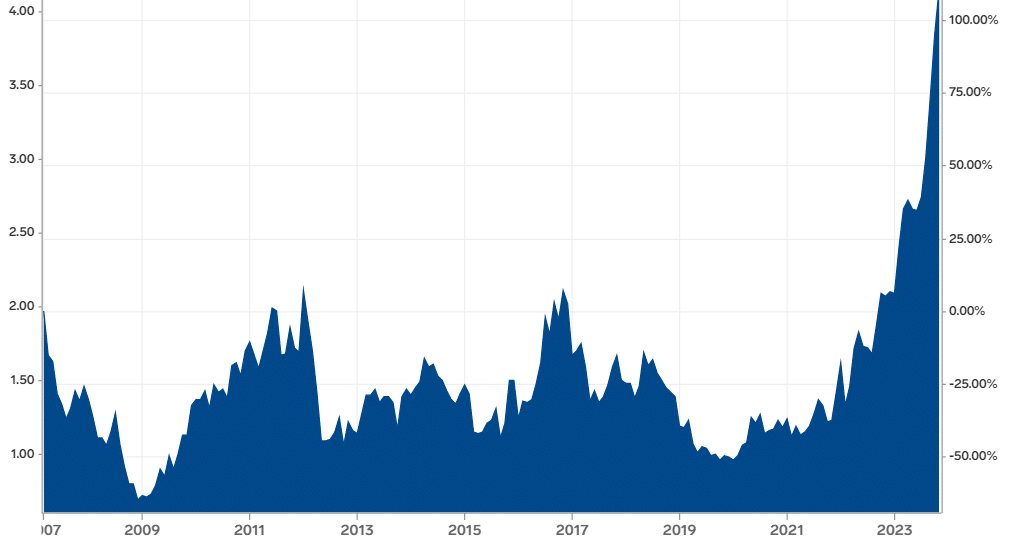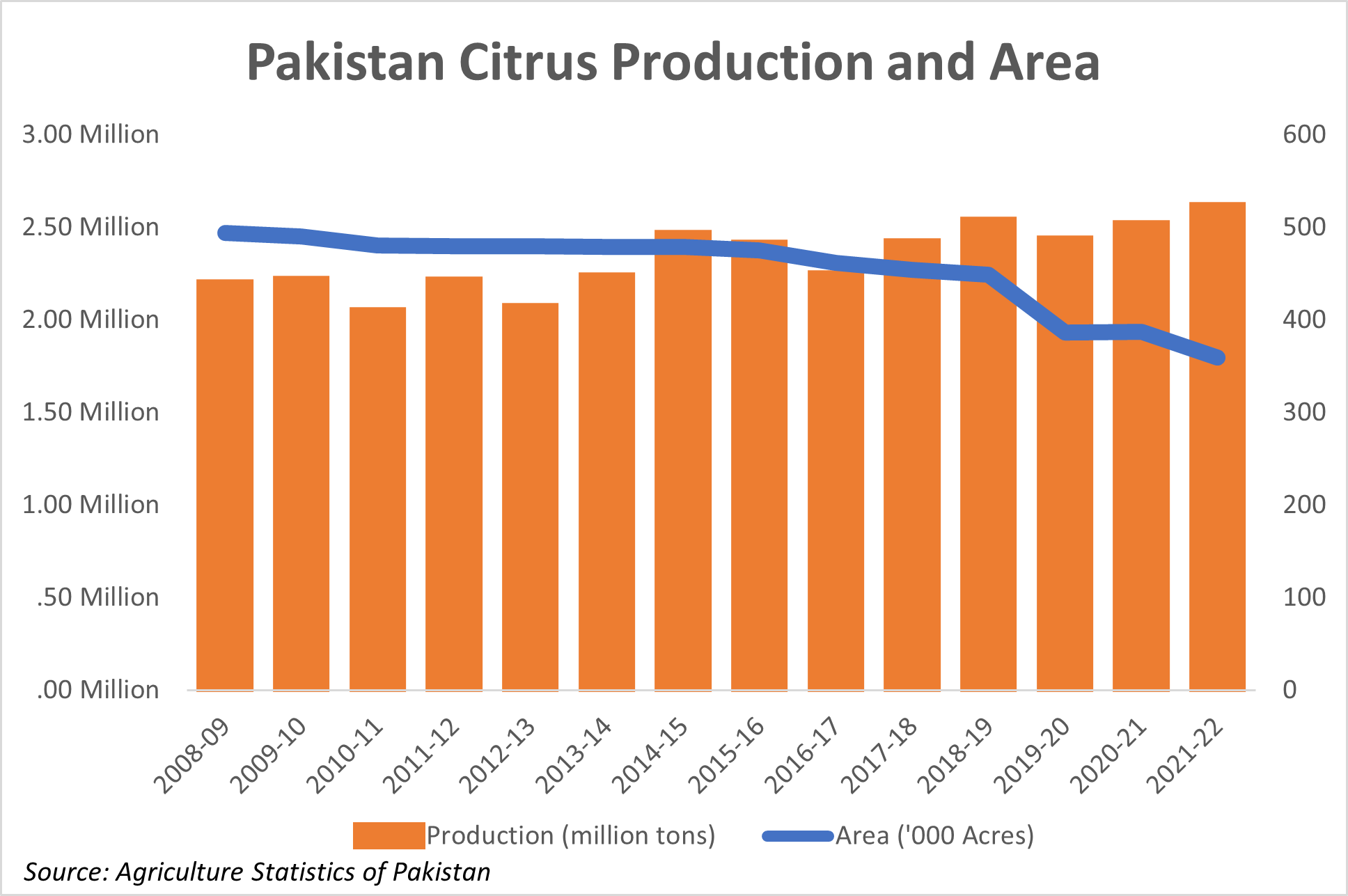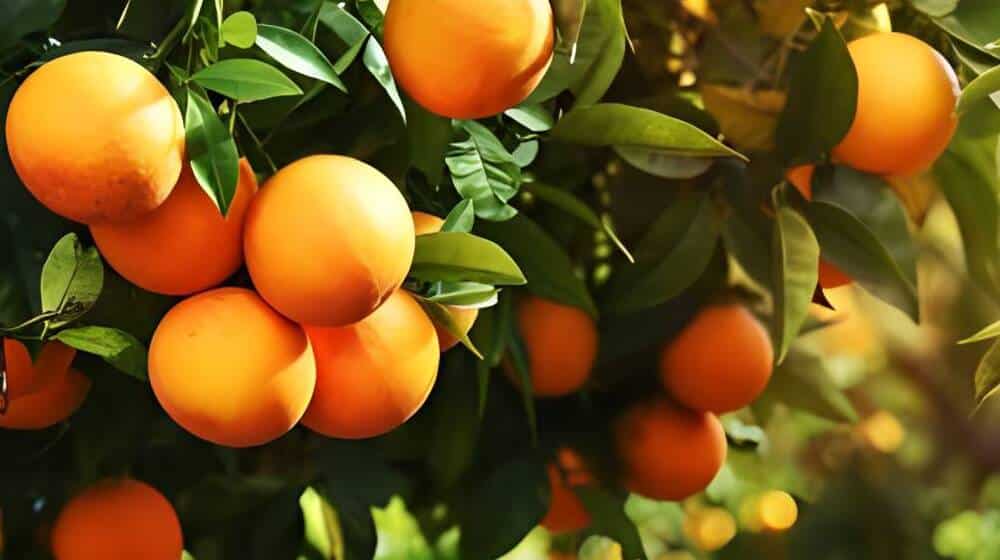Do you know international orange juice prices have increased by more than 300 percent since 2020, clocking to an all-time high? Some even joke that it may beat certain hedge funds out there but why?
Given extreme weather events and disease outbreaks hurting both near and long-term prospects of a thinly traded market, a constrained production outlook from the United States, Brazil and Mexico has played a key role in this development.

Pakistan stands as the 13th-largest citrus producer globally, consistently yielding 2 to 2.4 million tonnes annually from approximately 200,000 hectares over the past decade.
Pakistan’s citrus production has increased marginally between 2018 and 2022 from 2.35 million tons to 2.55 million tons but the cultivated area has actually declined by nearly 20 percent from 0.45 million acres to 0.35 million acres during the same time.

Pakistan is not immune to the ghosts haunting orchards globally with a mysterious and devastating disease sweeping through citrus groves worldwide for years including Pakistan, leaving a trail of withered trees and unanswered questions in its wake.
This sudden death syndrome, known as citrus sudden death (CSD), has baffled scientists and growers alike across the globe. Some say it caused due to citrus sudden death-associated virus (CSDaV) which may have spread through aphids.
Others blame a bacterium candidatus liberibacter citri or a certain fungus as a reason while it is also possible that environmental stress factors such as flooding and nutrient deficiency play a more important role in its occurrence and transmission.
The disease, first identified in Brazil in the early 2000s, has since spread to other major citrus-growing regions, including Argentina, Paraguay, Australia, Pakistan and South Africa.
It is characterized by the rapid decline and death of citrus trees, often within months or even days. Affected plants & trees exhibit various symptoms, including wilting, yellowing leaves, and fruit drop.
The Recent Wave
Well-informed sources have told ProPakistani that this year too farmers have experienced a more significant outbreak of this disease in Toba Tek Singh, which is the major production region after Sargodha.
Some farmers have even spent from a few lacs to nearly half a million on their crops in the name of pesticides and fungicides to curb this ‘disease’. These are sold by salesmen claiming to cure something even international researchers have struggled to find the right cause let alone a cure.
“It is true that more plants have experienced death this year given higher than expected fruiting against insignificant nutrition,” stated Deputy Director Agriculture Extension Horticulture in District Sargodha Dr Basharat Ali Saleem while talking to ProPakistani
He added that sudden death is mostly a management issue with some role played by fungus, and intercropping with incompatible crops like Wheat which leads to irrigating or drying the orchard at the wrong time given citrus cannot survive standing water for more than four days.
The industry faces numerous other challenges as well where issues related to pests, diseases, pruning, nutrition, and irrigation, low profitability hinder the widespread adoption of improved practices.
Only 10 percent of the citrus crop is earmarked for export as deficient value chains and ineffective cropping practices have curtailed export growth.
“We characterize sudden death often as a symptom of multiple other diseases and stress factors rather than a disease on its own and it’s true that researchers have been unable to figure out an authentic cause up to this day,” stated Dr Azher Nawaz, Citrus Expert and Associate Professor at the Department of Horticultural Sciences, Islamia University Bahawalpur while talking to ProPakistani
However he noted that it is a conclusive fact that where orchards are managed effectively and provided nutrients and pesticides in a timely manner as per recommendations, they rarely suffer sudden death.
He added that in addition to the occurrence of the fungus phytophthora, the use of unhealthy rootstock (underground plant part from which new plant is produced) by largely unregulated nurseries is also a major factor contributing towards this syndrome.
A Bigger Threat Emerging?
Talking about the larger threats to the industry, Dr Nawaz also noted observing symptoms of huanglongbing (HLB) or citrus greening disease in certain orchards in Sargodha which has also become one of the biggest threats to orchards in the West and primarily fueling the recent supply crunch.
HLB has affected 100 million trees across 40 countries and has scared away farmers and investors from upgrading the farms and processing units. It’s a bacterial disease transmitted by an Asian citrus psyllid and causes fruit size reduction, bitter taste, mottling of the fruit skin, tree decline, and eventually, death.
On the other hand, nobody knows for sure the cause, transmission or a single directly effective control measure for CSD, so one can argue that it’s deadlier but I wouldn’t lose my sleep over it since we as a country, are not ready for either.
People would laugh outright if I asked anyone if it is a government priority to plan for and take head on one of the biggest threats to our citrus economy. The priorities at the government level are not hidden from anyone so let’s not even go there.
| Feature | Huanglongbing (HLB) | Citrus Sudden Death (CSD) |
| Cause | Candidatus Liberibacter asiaticus (Las) bacteria | Unknown |
| Transmission | Asian citrus psyllid (Diaphorina citri) | Unknown |
| Distribution | Widespread | Widespread |
| Symptoms | Fruit size reduction, bitter taste, mottling of the fruit skin, tree decline, and death | Wilting and death of citrus trees within a few days |
| Control | Several effective control measures are available | No direct effective control measures are available |
Overlooked Market Dynamics
We concluded above that the lack of effective management is the key reason and only way out for the growers but do they don’t know that?
It has been an easier course for the drawing room policymakers to just label the farmers dumb and ignorant and go to sleep that way but things are far more complicated on the ground in the agriculture sector.
Saleem argued that the bigger problem is not the lack of awareness as there are more than two dozen government departments educating farmers but the issue is that farmers just don’t take orchards as other crops.
And that’s true. In most rural households, orchards are considered only passive income sources and even the big landlords only hold onto them so they can gift fruits to their friends and families and show off rather than export high-value citrus.
It’s also believed that orchard farmers are more capital-heavy and can invest in modern farming practices and quality seeds & inputs but I guess our farmers are just farmers across the board and there is a limit to which people can stretch themselves against the recent economic shocks the country has experienced in past years.
According to the Australian Centre of International Agriculture Research (ACIAR) in Pakistan, 60 percent of citrus growers operate on less than 2 hectares of land, with 72 percent possessing less than 5 hectares.
Nearly 95 percent of these growers pre-sell their crop to preharvest contractors, limiting their agency to influence prices and restricting access to crucial marketing knowledge. This lack of control is a disincentive for smallholders to invest in practices and technology that could potentially increase fruit production aligned with consumer preferences.
There is a need to change the perception of orchards among farmers through success stories of farmers who have transformed their orchards into profitable ventures using modern techniques and involving influencers and community leaders to promote the economic benefits of investing in citrus orchards.
It’s also imperative to facilitate direct market linkages and build community-driven cooperatives for smallholder farmers, allowing them to bypass preharvest contractors, negotiate better and sell their produce at better prices and encourage diversification of citrus products to create more income streams for growers.






















